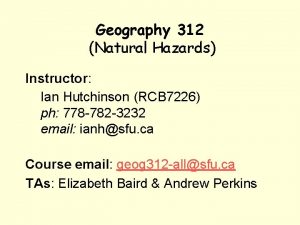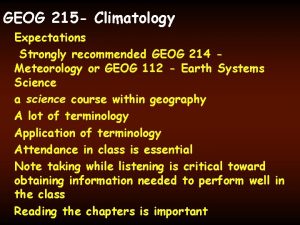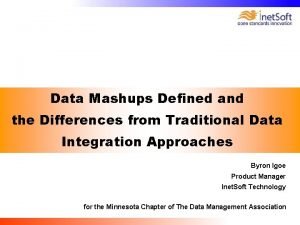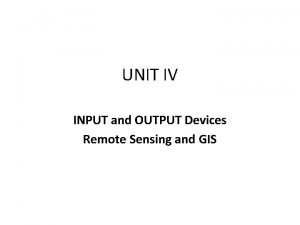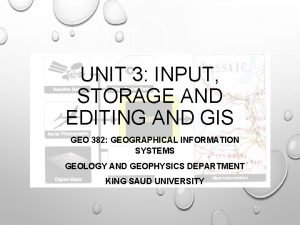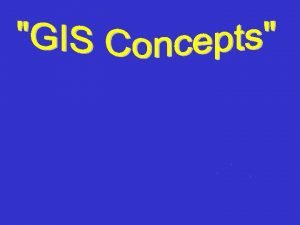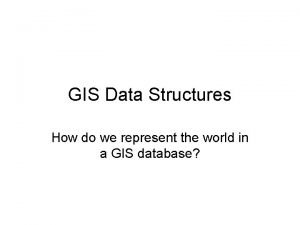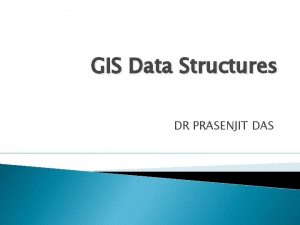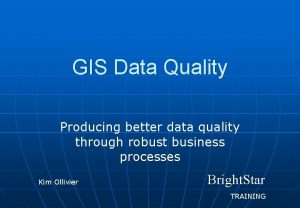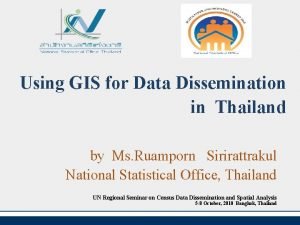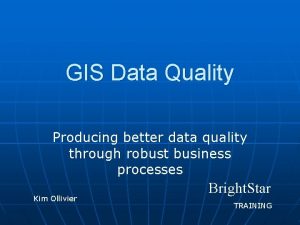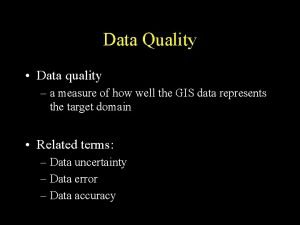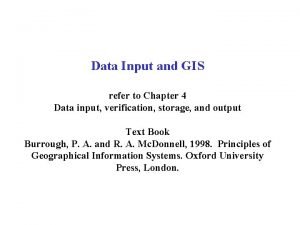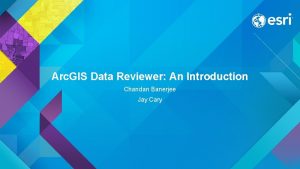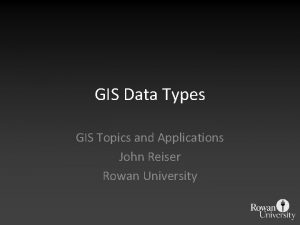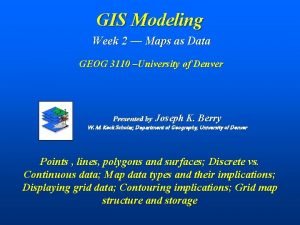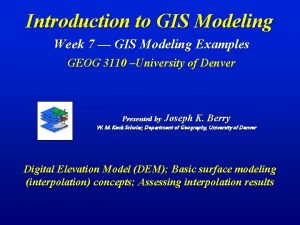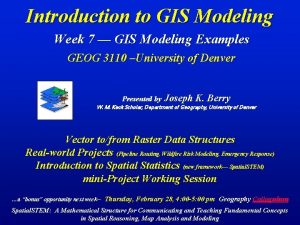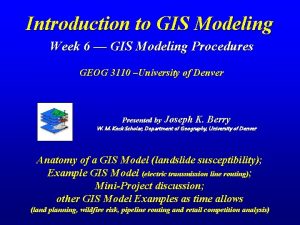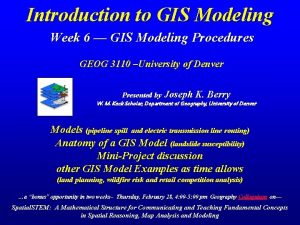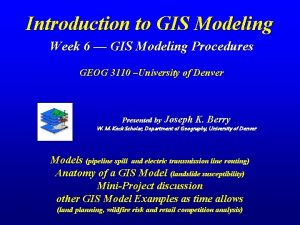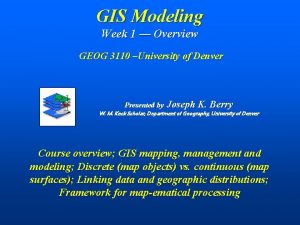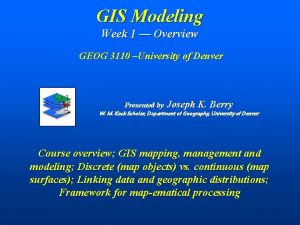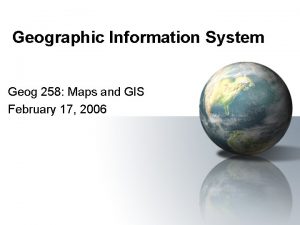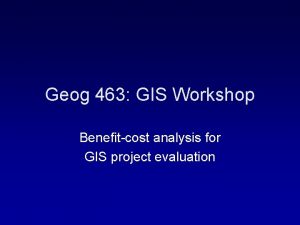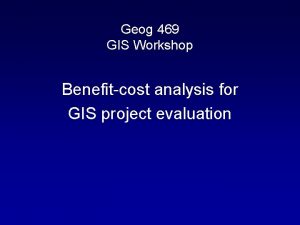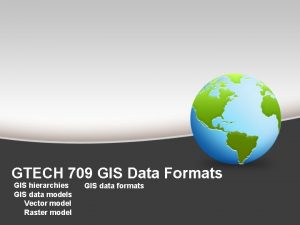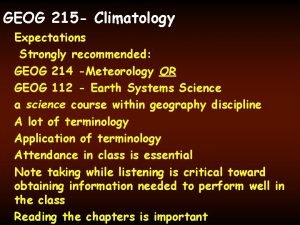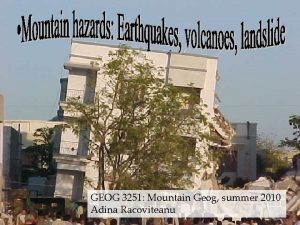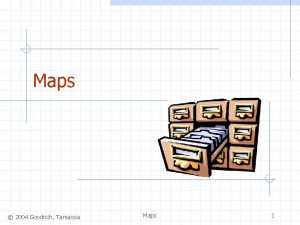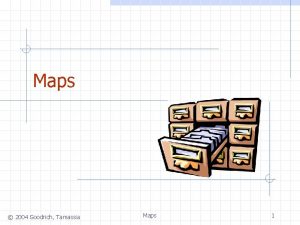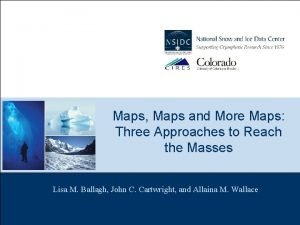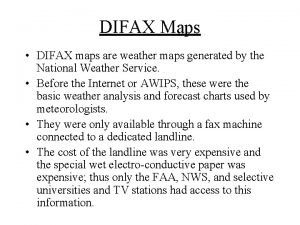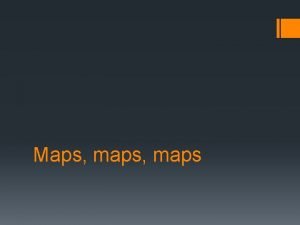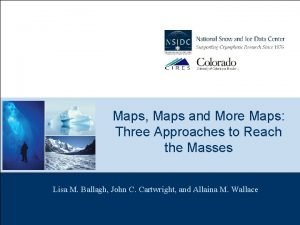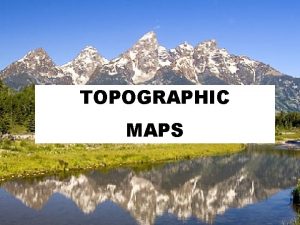GIS Modeling Week 2 Maps as Data GEOG





























- Slides: 29

GIS Modeling Week 2 — Maps as Data GEOG 3110 –University of Denver Presented by Joseph K. Berry W. M. Keck Scholar, Department of Geography, University of Denver Points , lines, polygons and surfaces; Discrete vs. Continuous data; Map data types and their implications; Displaying grid data; Contouring implications; Grid map structure and storage

Who We Are (Class Photo) Annotated Class Roster posted at… http: //www. innovativegis. com/basis/Courses/GMcourse 10/Syllabus/GM 2010_roster. pdf <as of Thursday morning>

Now, Where We? What GIS Is (and isn’t) Computer Mapping (70’s) - Spatial d. B Management (80’s) - GIS Modeling (90’s) GIS Modeling ü Spatial Analysis — “contextual” relationships within and among mapped data (Reclassify, Overlay, Distance, Neighbors) ü Spatial Statistics — “numerical” relationships within and among mapped data (Surface Modeling and Spatial Data Mining) From mapping to Spatial Reasoning… …that radically changes our Map Paradigm …keeping in mind that the frontier is currently focused on Multimedia Mapping (00’s) (Berry)

Campground Suitability Model Review (Logic) Prefer Gentle Slopes, Near Roads, Near Water, View of Water and Westerly Oriented …but can’t be too close to water or too steep 1 2 3 4 1) Base maps 2) Derived maps 6 3) Interpreted maps 4) Combined / Modeled maps 5) Constraint maps 5 6) Final map (Berry)

Campground Suitability Model Review (Solution) A sequencing of map analysis commands are applied to implement model logic— using a command script (Tutor 25_Campground. scr) Solution set of maps are created by evaluating the model logic for the unique pattern of conditions at each geographic location …grid cell (Berry) Hands-on Review

Basic Map Features Manual cartography utilizes points, lines and areas as the basic building blocks for characterizing geographic space Based on spatial objects (discrete) New map feature type based on grid cells (continuous) …traditionally all maps are composed of three fundamental map features—Points, Lines and Areas. The digital map provides additional dimensions of depth and time to extend the features to Surfaces, Volumes, hyper-Volumes and fuzzy-Features (Berry)

Storing Points, Lines and Areas …how do you think Vector and Raster data structures store Surfaces, Volumes, hyper-Volumes and fuzzy-Features? (Berry)

Spatial Resolution The concept of Scale (S= MD/GD) does not exist in a GIS …heresy!!! …replaced by the concept of Resolution (Spatial, Mapping, Thematic and Temporal) (Berry)

Minimum Mapping Resolution …replaced by the concept of Resolution (Spatial, Mapping, Thematic and Temporal) (Berry)

Thematic and Temporal Resolutions …replaced by the concept of Resolution (Spatial, Mapping, Thematic and Temporal) …so what is the difference between the concepts of PRECISION and ACCURACY …and how do these concepts relate to the concept of RESOLUTION? (Berry)

Accuracy versus Precision The Wikipedia defines Accuracy as “the degree of veracity” (exactness) while Precision as “the degree of reproducibility” (repeatable) Accuracy describes the closeness of arrows to the bull’s-eye at the target center (actual/correct) High Accuracy but Low Precision Handheld GPS unit Accuracy vs. Precision …the “target analogy” compares measurements to the pattern of arrows shot at a target High Precision but Low Accuracy Precision GPS unit Precision relates to the size of the cluster of arrows— grouped tightly together is considered precise (Berry)

Classification versus Delineation (spatial perspective) Interpreter A Interpreter B Interpreter C Vegetation Parcel Mapping Accuracy = classification (What) Photo Interpreter A Cottonwood Superimposed interpretation boundaries Precision = delineation (Where) Photo Interpreter B Ponderosa Pine Photo Interpreter C Cottonwood Classification Accuracy (What) Delineation Precision (Where) (Berry)

Model Accuracy/Precision (spatial modeling perspective) Routing Criteria Most Preferred 1 2 Calibrate Expert Opinion Least Preferred 3 4 5 6 7 8 HD & VE times 10 Homeowners 9 Housing Density Road Proximity RP & SA times 10 Sensitive Areas Visual Exposure HD & RP times 10 Environmentalists …cognitive mapping has no definitive right/wrong solution— Engineers Weight Stakeholder Values Most Preferred Start Optimal Path Optimal Corridor Engineers Environmentalists Average of the three cost surfaces Homeowners Individual Solutions Start End Combined Solution End (Berry)

Raster Data Types It is important to note that the map features in a vector-based mapping system identify discrete, irregular spatial objects with sharp abrupt boundaries. Other data types — grid surfaces, raster images and pseudo grids — treat space in entirely different manner to portray spatially continuous data …in a raster image the values stored at each map location identify its color (hue, saturation and brightness)– constrained integer value …mapped data ready for map analysis and modeling GIS Maps contain— • Points, lines, polygons • Grid surfaces • Raster images • Pseudo grids …in a pseudo grid each grid element is treated as a separate polygon (square) with spatial and attribute tables defining the set of little polygons (Berry)

Basic Grid Data Structure A Grid Map consists of a matrix of numbers with a value indicating the characteristic /condition at each grid cell location forming a geo-registered set of Map Layers or “Map Stack” Layer Mesh Lines Map Stack Grid Map Fill Analysis Frame The Analysis Frame provides consistent “parceling” needed for map analysis and extends discrete point, line and areal features to continuous Map Surfaces Col 3, Row 22 Layer Mesh Data listing for a Map Stack Drill-down

Basic Grid Display Types… Lattice display forms a smooth wireframe Grid display forms chunky extruded grids …so how is a Contour Map generated? Contour line 1900 (See Example Applications, “Display Types” for more information) (Berry)

Thematic Display (Shading Manager) Map. Calc Shading Manager… # Ranges sets the number of intervals Equal Ranges has the same range for each interval Equal Count has the same number of cells for each interval (See Example Applications, “Display Types” for more information) (Berry)

Contouring Mapped Data (Continuous to Discrete) üDisplay the elevation surface as wireframe (Lattice) with filled floor contours ü Set #Ranges to 7 and assign yellow as the inflection color ü Redisplay the surface as Equal Count, Equal Ranges, St. Dev and User Defined …note the dramatic differences in the shape and position of the boundary lines of the discrete contour intervals +/- 1 Stdev Equal Count Equal Ranges So which discrete map of elevation surface is CORRECT? User Defined (300 Step) (Berry)

Matching Data Types & Display Types/Forms Data Type… Data Type toggles between Discrete and Continuous data types Display Type… Use Cells toggles between Lattice and Grid display types Display Form… 3 D Toggle changes 2 D and 3 D display forms (See Example Applications, “Data Types”, “Color Interval/Pallet”, “ 3 D Display Options” and “Data Inspection and Charting” for related information) (Berry)

Numeric and Geographic Data Types …all digital maps are composed of organized sets of numbers— the Data Type determines what “map-ematical” processing can be done with the numbers on a map, or stack of map layers (Berry)

Homework Exercise #2 Part 1 – Understanding Basic Concepts and Terms • Scale and Resolution. 1) Map Scale, 2) Spatial Resolution, 3) Thematic Resolution, 4) Minimum Mapping Resolution and 5) Temporal Resolution. • Data Types. 1) Nominal, 2) Ordinal, 3) Interval, 4) Ratio, 5) Binary, 6) Choropleth, 7) Isopleth data types (be sure to distinguish which data types are Numeric and which are Geographic) • Display Considerations. You will generate different map displays of the Slope and Districts map layers, then identify/comment on the Data Type, Display Type and Display Form used and discuss the effects/appearance of the different displays Part 2 – Characterizing Geographic Space …Discrete versus Continuous Thematic Mapping • . You will use the Shading Manager to create different map displays while investigating the effects of Calculation Mode (Equal Ranges, Equal Count, +/- 1 Standard Deviation and User Defined), Number of Ranges and Color Ramp assignments. (Berry)

Simple Erosion Model (Exercise #2, Part 3) üCreate a slope map üReclassify that map for slope classes üCreate a flow map üReclassify that map for flow classes üCombine the maps of slope classes and flow classes ü…result is a map with a 2 -digit code 1 St digit = flow class 2 nd digit = slope class (Berry)

So Where Are You in GIS? General and Innovative Users– uses understanding of basic concepts, capabilities and considerations in developing new applications within their discipline …changing our Map Paradigm The “bookends” of this continuum are the current drivers of Geotechnology “…of the Discipline” “…of the Computer” “…of the Application” Computer Programmer– Solutions Developer– Systems Manager– develops GIS tools; mostly computer science with some courses in GIS develops GIS applications that link GIS to realworld problems; mostly GIS/CS with some disciplinary expertise develops and maintains spatial databases and connections within (LAN) and outside (Internet) the organization; CS and GIS balance (See Beyond Mapping III, Topic 4, “Where Is GIS Education”) Data Provider – develops GIS data layers; good skills in GPS and remote sensing with strong skills in GIS data formats and geodetic referencing GIS Specialist– uses discipline expertise and GIS knowledge for basic GIS applications and interacts with solution developers to address complex spatial problems (Berry)

Vector to/from Raster (direct calculation) V to R– burning the points, lines and areas into the grid (fat, thin and split) R to V– connecting grid centroids, sides and edges (line smoothing) (Berry)

Vector to Raster (centroid implied) V to R– uses a point file of cell centroids and converts polygon features that intersect Implied Grid with Centroids Centroid Point File Vector Map (polygons) …as the points fall Note: this technique is very sensitive to cell size (features smaller than cells) and complexity of boundary shape The corresponding grid cell is assigned the value of the “point in polygon intersection” …but it is really fast Raster Map Polygons with Overlaid Points (Berry)

Exporting Map. Calc Data Layers ESRI Grid. ASCII Format just for fun (you are having fun, right? )— Export the Map. Calc Tutor 25. rgs Elevation map layer in both ESRI Grid. ASCII format and Surfer ASCII format …browse to an appropriate folder and Save exported file Surfer ASCII Format (Berry)

Grid-based Data Structures/Formats (Esri. asc) …open the ELEV. asc file in Notepad to see the data structure (stored as an Individual File) <export Elevation as ESRI_elevation. asc and open in Note. Pad> Map Data (Bottom portion) Origin is upperleft corner …values along the row, left to right in a block (25) General Information (“header” first 6 records) #Row #Col Longitude of LL corner Latitude of LL corner Cell size (in decimal degrees) No Data value (null) Each block contains all of the map values for a row …next row up …repeat for all rows (625 total) (Berry)

Grid-based Data Structures/Formats (Surfer. grd) …open the ELEV. grd file in Notepad to see the data structure (stored as an Individual File) <export Elevation as Surfer_elevation. grd and open in Note. Pad> Map Data (Bottom portion) Origin is lowerleft corner …values along the row, left to right in a block (25) General Information (“header” first 5 records) File Type #Row #Col Each block contains all of the map values for a row Lon/Lat LL and UR Min and Max Value …next row up …repeat for all rows (625 total) (Berry)

Grid-based Data Structures/Formats (Map. Calc. rgs) …open the Tutor 25. rgs in Notepad to see the data structure (stored as a Data Table) …open Tutor 25. rgs in Notepad Map Data (Bottom portion) Origin is lowerleft corner …values for all columns along the row, left to right (25) General and Map Legend Information (top portion) Each column contains all of the map values for a layer …next row up …repeat for all rows (625 total) (Berry)
 Helen c. erickson
Helen c. erickson Dimensional modeling vs relational modeling
Dimensional modeling vs relational modeling Aldeeky
Aldeeky Reittihaku google maps
Reittihaku google maps Unit 1 geog. of ga/ga’s beginnings
Unit 1 geog. of ga/ga’s beginnings Free floating subdivisions
Free floating subdivisions Geog 312 sfu
Geog 312 sfu Hkdse geography 2020
Hkdse geography 2020 Geog 214
Geog 214 Geog
Geog Data mashups and gis are data integration technologies.
Data mashups and gis are data integration technologies. Google earth
Google earth Week by week plans for documenting children's development
Week by week plans for documenting children's development Oracle data warehouse best practices
Oracle data warehouse best practices Data input devices in a gis is
Data input devices in a gis is Gis data input
Gis data input Big data and gis
Big data and gis Component of gis
Component of gis Gis data structure types
Gis data structure types Gis data structure
Gis data structure Data quality in gis
Data quality in gis Gis data validation
Gis data validation Giscont
Giscont Data quality in gis
Data quality in gis Data quality in gis
Data quality in gis Gis data input
Gis data input Gis data validation
Gis data validation Polk county gis florida
Polk county gis florida Gis data types
Gis data types Attribute data query in gis
Attribute data query in gis






